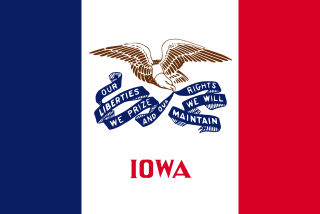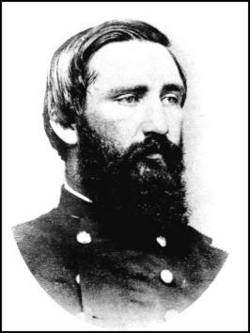
Campbellton is a town in Jackson County, Florida, United States. The town is part of the Florida Panhandle in North Florida, and has a predominately African American majority. The population was 191 at the 2020 census.

The Battle of Pea Ridge, also known as the Battle of Elkhorn Tavern, took place during the American Civil War near Leetown, northeast of Fayetteville, Arkansas. Federal forces, led by Brig. Gen. Samuel R. Curtis, moved south from central Missouri, driving Confederate forces into northwestern Arkansas. Maj. Gen. Earl Van Dorn had launched a Confederate counteroffensive, hoping to recapture northern Arkansas and Missouri. Confederate forces met at Bentonville and became the most substantial Rebel force, by way of guns and men, to assemble in the Trans-Mississippi. Against the odds, Curtis held off the Confederate attack on the first day and drove Van Dorn's force off the battlefield on the second. By defeating the Confederates, the Union forces established Federal control of most of Missouri and northern Arkansas.

The Battle of Philippi formed part of the Western Virginia Campaign of the American Civil War and was fought in and around Philippi, Virginia, on June 3, 1861. A Union Army victory, it was the first organized land action of the war, though generally viewed as a skirmish rather than a battle.

The Battle of Sailor's Creek was fought on April 6, 1865, near Farmville, Virginia, as part of the Appomattox Campaign, near the end of the American Civil War. It was the last major engagement between the Confederate Army of Northern Virginia, commanded by General Robert E. Lee, and the Army of the Potomac, under the overall direction of Union General-in-Chief Lieutenant General Ulysses S. Grant.

The siege of Lexington, also known as the First Battle of Lexington or the Battle of the Hemp Bales, was a minor conflict of the American Civil War. The siege took place from September 13 to 20, 1861 between the Union Army and the pro-Confederate Missouri State Guard in Lexington, county seat of Lafayette County, Missouri. The victory won by the Missouri Guard bolstered the considerable Southern sentiment in the area, and briefly consolidated Missouri State Guard control of the Missouri River Valley in the western part of the state.

The First Battle of Boonville was a minor skirmish of the American Civil War, occurring on June 17, 1861, near Boonville in Cooper County, Missouri. Although casualties were extremely light, the battle's strategic impact was far greater than one might assume from its limited nature. The Union victory established what would become an unbroken Federal control of the Missouri River, and helped to thwart efforts to bring Missouri into the Confederacy.

Price's Missouri Expedition, also known as Price's Raid or Price's Missouri Raid, was an unsuccessful Confederate cavalry raid through Arkansas, Missouri, and Kansas in the Trans-Mississippi Theater of the American Civil War. Led by Confederate Major General Sterling Price, the campaign aimed to recapture Missouri and renew the Confederate initiative in the larger conflict.
Wilson's Raid was a cavalry operation through Alabama and Georgia in March–April 1865, late in the American Civil War. U.S. Brig. Gen. James H. Wilson led his U.S. Cavalry Corps to destroy Confederate manufacturing facilities and was opposed unsuccessfully by a much smaller force under Confederate Lt. Gen. Nathan Bedford Forrest.

Florida participated in the American Civil War as a member of the Confederate States of America. It had been admitted to the United States as a slave state in 1845. In January 1861, Florida became the third Southern state to secede from the Union after the November 1860 presidential election victory of Abraham Lincoln. It was one of the initial seven slave states which formed the Confederacy on February 8, 1861, in advance of the American Civil War.
The Battle of Marianna was a small but significant engagement on September 27, 1864, in the panhandle of Florida during the American Civil War. The Union destruction against Confederates and militia defending the town of Marianna was the culmination of a substantial Federal cavalry raid into northwestern Florida. Ultimately, the Union force withdrew to Fort Barrancas.
The Battle of Middle Boggy Depot, also known as the Battle of Middle Boggy River or simply Battle of Middle Boggy, took place on February 13, 1864 in Choctaw Indian Territory, 4 miles (6.4 km) south of what is now Allen in Pontotoc County, Oklahoma. Advancing down the Dragoon Trail toward Fort Washita, Union Colonel William A. Phillips sent out an advance of approximately 350 men from the 14th Kansas Cavalry and two howitzers to attack a Confederate outpost guarding the Trail's crossing of Middle Boggy River. The Confederate force was led by Captain Jonathan Nail and composed of one company of the First Choctaw and Chickasaw Cavalry, a detachment of the 20th Texas Cavalry and part of the Seminole Battalion of Mounted Rifles. The outpost was about 12 miles (19 km) from Muddy Boggy Depot, which was held by the Confederates. The Encyclopedia of Oklahoma History and Culture says that the battlefield was 15 miles northeast of the depot, whereas the battlefield marker says the distance was 12 miles. The Confederate force at the outpost, consisting of 90 poorly armed men, were caught off guard when Willetts attacked them. Outnumbered and outgunned, the Confederates held off the Union cavalry attack for approximately 30 minutes before retreating to the rest of Lt. Col. John Jumper's Seminole Battalion, who were not at the main skirmish. The Confederates retreated 45 miles (72 km) southwest down the Dragoon Trail. The Union advance continued south toward Ft. Washita the next day, but when the expected reinforcements did not arrive Philips' Expedition into Indian Territory stalled on February 15, near old Stonewall.

The 1st Iowa Cavalry Regiment was a cavalry regiment that served in the Union Army during the American Civil War.
The Battle of Cole Camp was a skirmish of the American Civil War, occurring on June 19, 1861, in Benton County, Missouri. The Union loss provided an open path for the fleeing governor and Missouri State Guard away from Lyon's force in Boonville.

The 53rd Pennsylvania Volunteer Infantry was a volunteer infantry regiment in the Union Army during the American Civil War.
The Skirmish at Blackwater Creek, also known as the Skirmish at Milford, was an American Civil War skirmish that took place in central Missouri on December 19, 1861 near present-day Valley City. It was a victory for the North.
The Battle of Newton was a minor skirmish that took place in the small town of Newton, Alabama, on 14 March 1865, during the final days of the U.S. Civil War. It was fought between local Home Guard troops and elements of the 1st Florida Cavalry (US), who had invaded the Wiregrass region of Alabama. This operation had not been approved by Brigadier General Alexander Asboth, commanding Union forces in Pensacola, Florida, and was in fact a violation of Ashboth's operational order.
Joseph G. Sanders was a soldier from the U.S. state of Alabama who served as a commissioned officer in both the Confederate and Union armies during the U.S. Civil War. After initially joining the 31st Georgia Infantry Regiment as a private in 1861, he was elected captain of Company C in that regiment a year later, fighting for the South until he resigned his commission in January 1864 and returned to Alabama, claiming ill health.
Forrest's Expedition into West Tennessee was a raid conducted by Confederate Brigadier General Nathan Bedford Forrest in Tennessee from December 1862 to January 1863, during the American Civil War. Forrest led an expedition of 1,800 to 2,500 men into Union-held West Tennessee to disrupt the supply lines of Major General Ulysses S. Grant, who was campaigning south along the Mississippi River toward Vicksburg.

The Battle of Dug Springs, also known as the Rains Scare, was a part of the Trans-Mississippi Theater of the American Civil War. It was fought on August 2, 1861, near Clever, Missouri.

Sanders' Knoxville Raid saw 1,500 Union cavalry and mounted infantry led by Colonel William P. Sanders raid East Tennessee before the Knoxville campaign during the American Civil War. The successful raid began at Mount Vernon, Kentucky and moved south, passing near Kingston, Tennessee. Moving east from the Kingston area, the raiders struck the East Tennessee and Georgia Railroad at Lenoir Station. The Union horsemen rode northeast along the railroad, destroying track, bridges, and property useful to the Confederate States of America. Blocked from seizing Knoxville by its 1,000 Confederate defenders, Sanders' horsemen destroyed a major bridge across the Holston River at Strawberry Plains on the East Tennessee and Virginia Railroad. After wrecking a smaller bridge at Mossy Creek, the raiders turned northwest, evading pursuers by slipping through an obscure gap in the Cumberland Plateau. Sanders' men reached Boston, Kentucky on June 24, having captured and paroled over 400 Confederate soldiers while sustaining minimal losses in men but considerable losses in horses.











